Last Chance to Catch NYC's Holiday Notalgia Train
We met the voices of the NYC subway on our nostalgia ride this weekend!


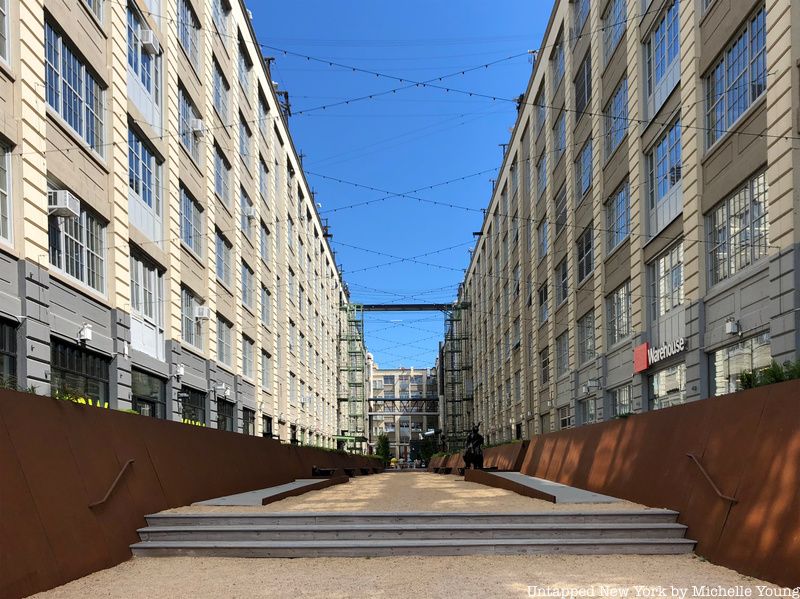
Industry City in Sunset Park, Brooklyn is known for its plethora of design stores and innovative dining locations, set within a predominantly minority community of Chinese and Hispanic residents. Visitors have the opportunity to shop at one of its more than fifty retail locations, including outlets for ABC Carpet & Home, Restoration Hardware and Design Within Reach, before taking time to relax in its courtyards which offer access to mini-golf, fire pits, and outdoor yoga classes. The facility also serves as a prime location to view thought-provoking public art installations, listen to live Latin music, and participate in workshops.
Yet, the complex’s past life is ever-present in the architecture. Known in the past as Bush Terminal, Industry City is the result of a transformation of a historic shipping and manufacturing complex located on the Upper New York Bay waterfront. Founded during the 1890s, Bush Terminal quickly helped to transform Brooklyn into a major international seaport—employing over 25,000 workers at its peak. Due to Bush Terminal’s railroad connection with the Brooklyn Army Terminal and the mainland United States, the facilities came to be utilized by the United States Navy as a base during World War I. It would later be revealed in a 1929 Brooklyn Daily Eagle article that during the war, Bush Terminal had handled around 70% of the ammunition, clothing, and food that was shipped overseas to American soldiers. Around the early 1950s, the terminal’s buildings began to be advertised as Industry City, in reference to how Bush Terminal had become one of the first industrial parks in the United States. However, following the end of World War II, the terminal’s shipping activity began to decline with the introduction of containerized shipping and the construction of the Port Newark-Elizabeth Marine Terminal in New Jersey, leading to a 50-year period of divestment and decay.
The facility was purchased by Belvedere Capital Real Estate Partners and Jamestown Properties in 2013. A $450 million redevelopment project was launched, turning Industry City into a manufacturing, office, and commercial hub. Today, Industry City comprises 16 buildings across 35 acres of repurposed industrial space. From having been the site of one of New York City’s largest explosions to containing the training facilities for the NBA’s Brooklyn Nets, Industry City houses countless secrets ready to be discovered.
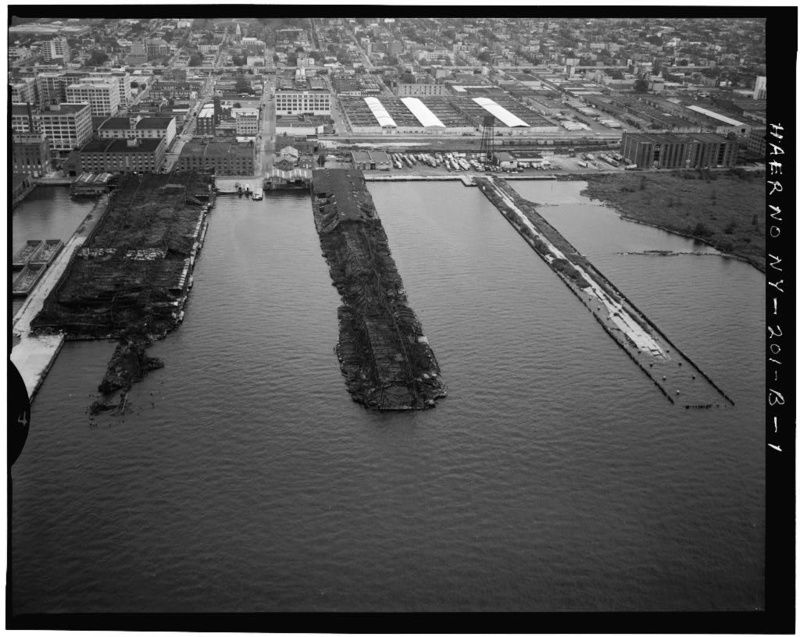
On December 3, 1956, the flagship dock of the Bush Terminal cargo shipping complex, located at the end of 35th Street, was the site of one of New York City’s largest explosions. At 3:15 p.m., longshoremen on the north end of the pier were using a torch to repair cargo-handling equipment when sparks and bits of metal began to fall to the ground. This ignited a pile of flammable foam rubber which quickly spread across the pier. Though firefighters arrived quickly to help mitigate the damage, thick black smoke created from the burning rubber made the fire difficult to contain. Unbeknownst to the four fire boats at the scene, 37,000 pounds of Primacord, a ropelike material typically used in controlled detonations, was located close to the fire.
Around 30 minutes later at 3:41 p.m., the detonation material caught fire and a large explosion eviscerated the southern midsection of the pier, launching steel beams half a mile into the distance and rattling buildings all the way in Lower Manhattan. In addition, the explosion was so powerful it was heard over 35 miles away. None of the firefighters present were injured by the explosion as the debris was projected over their heads. However, the same could not be said for individuals located 1,000 feet or more away from the center of the blast. Overall ten people were killed and 247 were injured—many of which occurred when the accompanying shock wave to the explosion shattered glass up to a mile away. In a 2016 New York Times article, Tony Cuccia, recalled his experience of the explosion as a young boy, ultimately learning that his father was attempting to help open the door so people could escape from the fire when the explosion occurred, killing him. Inspired by his father’s heroism, Cuccia went on to become a paramedic and later joined the New York Police Department, which he retired from in 2002.
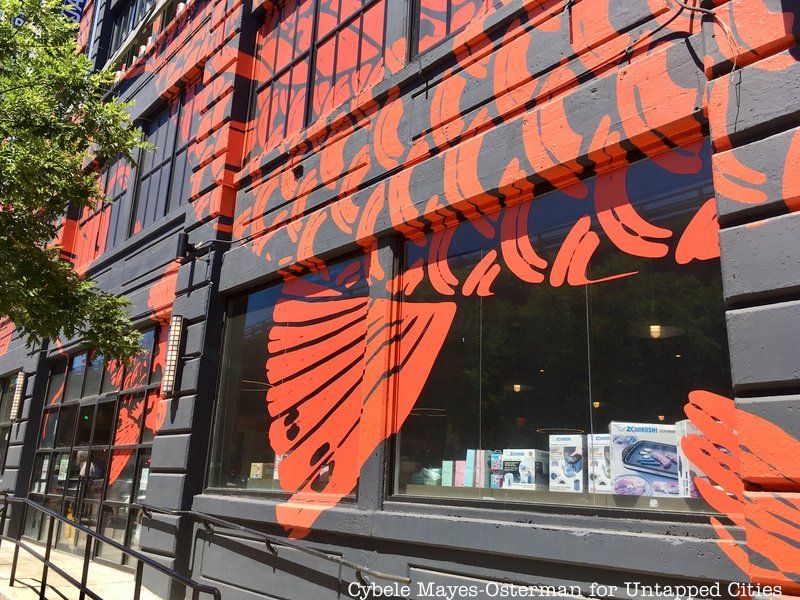
Opened in the spring of 2018, Japan Village is a 20,000-square-foot Japanese-themed marketplace right at the heart of Industry City. The marketplace centers itself around “omotenashi,” a Japanese approach that values hospitality, generosity, and mutual respect for guests. Japan Village is owned by Tony Yoshida (who created the East Village speakeasy Angel’s Share) and Takuya Yoshida, owners of the Michelin-star restaurant Kyo Ya and grocery store Sunrise Mart, which also has a branch in Japan Village.
In addition to Sunrise Mart, Japan Village also hosts a food hall with ten restaurants serving classic Japanese cuisine such as miso soup, bento boxes, and karaage fried chicken. You can also try Yakisoba (pan-fried noodles) and Taiyaki (fish-shaped sweets filled with a red bean or chocolate paste). Upon opening, Japan Village became the city’s third single-cuisine-focused food hall, joining Flatiron’s Eataly and the French-focussed Le District in the Financial District. Besides the food-hall restaurants, Japan Village also contains Wakuwaku, an Izakaya or Japanese bar which typically serves an assortment of small inexpensive snacks like chicken skewers or edamame accompanied by alcoholic beverages. In addition to Wakuwaku, visitors to Industry City can also stop by Japan Village’s Kuraichi which sells Japanese spirits and sake. Besides Japan Village, other dining options at Industry City include the Belgium pastry shop Colson Patisserie and Ejen, a Korean-comfort food restaurant.
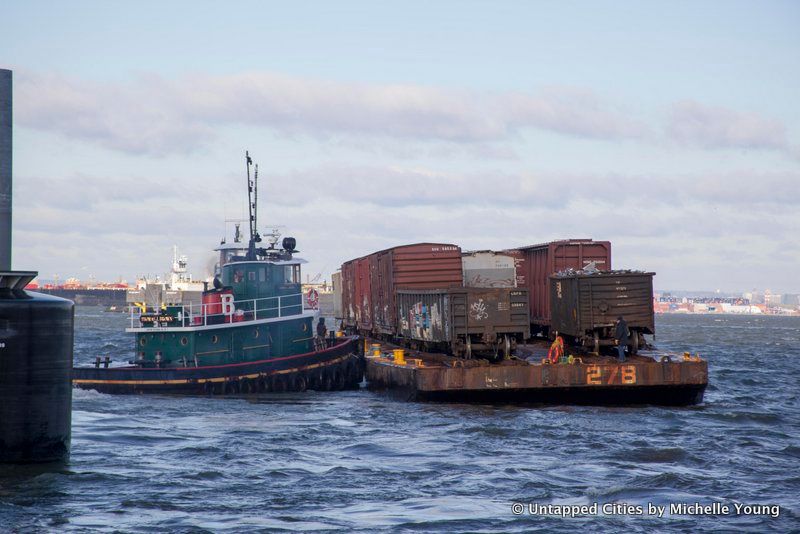
While walking around Industry City, you may see some railroad tracks in the road, and occasionally a train coming through to Brooklyn Army Terminal. At the 65th Street Rail Yard resides one of New York City’s infrastructure survivors—a floating barge freight train line operated by the Port Authority that runs from to the Greenville Yard in Jersey City across the Hudson River. Though the line is only four miles long, it serves as a critical link for freight transportation in the New York region and cements the city’s commitment to bringing industry back to the waterfront. Taking just 35 to 40 minutes to cross the Hudson River, the floats help to take trucks off the highway and give freight a more direct route between New York and New Jersey.
The current floats transport 14 train cars at once, an equivalent of 56 semi-trucks, on two tracks side by side, but new car floats are being built by the Port Authority that will have four tracks, accommodating 18 train cars (equivalent to 72 trucks) and providing faster unload and reload times. New York and New Jersey Rail transports a large amount of local lumber and building materials, as well as food products like soybean oil and Washington state apples, separated recycled materials from the SIMS Municipal Recycling Facility nearby and other solid waste like scrap metal. Special cargo have included New York City transit subway cars and oversize pieces for the Willis Avenue Bridge, which spans the Harlem River.
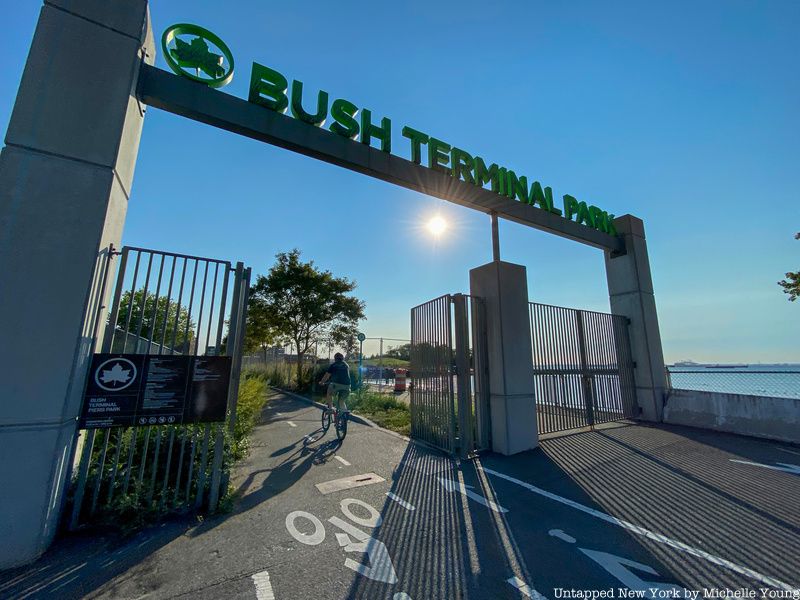
One of the Industry City area’s best-kept secrets is Bush Terminal Piers Park, a secluded 24-acre green space located between 43rd and 51st Streets. Though most of the park is obscured from view along First Avenue, and the entrance is through a building complex, it serves as an oasis amidst the industrial landscape of Sunset Park. Prior to the park’s creation, the land had been designated as a brownfield, a distinction it earned due to the illegal dumping of pollutants and construction debris during the 1970s which contaminated the water surrounding the piers of Bush Terminal. For almost two decades the area’s land laid abandoned until the 1990s when residents of Sunset Park began requesting for the city to construct a waterfront park in their neighborhood.
In 1997, New York State funded a $700,000 study conducted by the city’s Economic Development Corporation to determine if the land could be cleaned—wrapping up in 2002. Four years later city, state, and federal agencies issued $36 million in grants to clean up and transform the space into parkland with the park officially opening in November 2014. Today, visitors can utilize the park’s soccer and baseball fields, bicycle path, esplanade, and two saltwater tide pools. In addition, the park offers stunning views of the Upper Bay with the Statue of Liberty, Manhattan, Staten Island, and the New Jersey shoreline in plain sight. Bush Terminal Piers Park is also part of the Brooklyn Waterfront Greenway, a 21-mile off-street landscaped route for pedestrians, runners, and cyclists connecting neighborhoods, parks, and open spaces along Brooklyn’s waterfront from Greenpoint down to Owls Head Park in Bay Ridge.
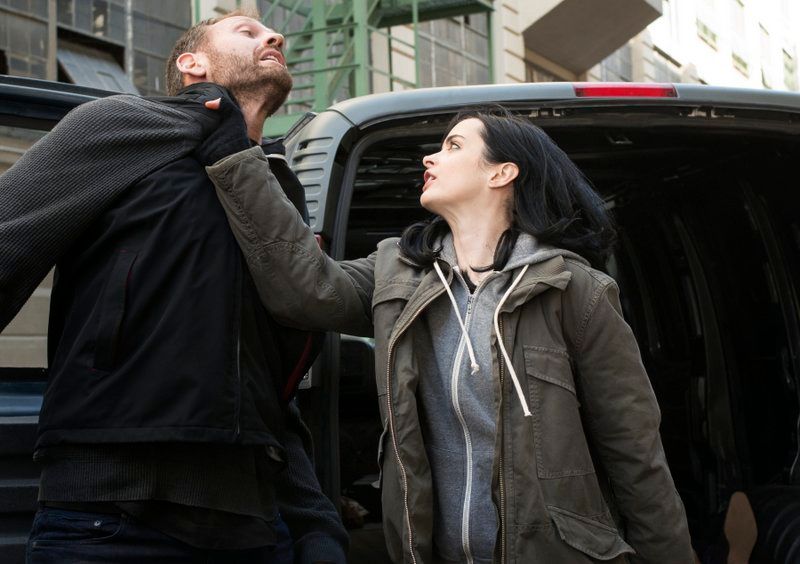
Some of the most well-known television series in recent years have set scenes within the walls of Industry City including Billions, a Showtime drama series about a ruthless New York City hedge fund manager and his off-and-on-again nemesis, the Manhattan District Attorney. In season 2 Industry City serves as the location of the factory producing Ice Juice, which the DA has invested in.
Besides Billions, Industry City has also been featured on the hit Netflix series Jessica Jones, which often relies on warehouse backgrounds as a prime component of its aesthetic. Exterior shots of Industry City accompany scenes in which Jessica keeps her enemy Kilgrave hostage. Industry City was also featured in the music video for the song “Man on Fire” by Edward Sharpe and the Magnetic Zeros.
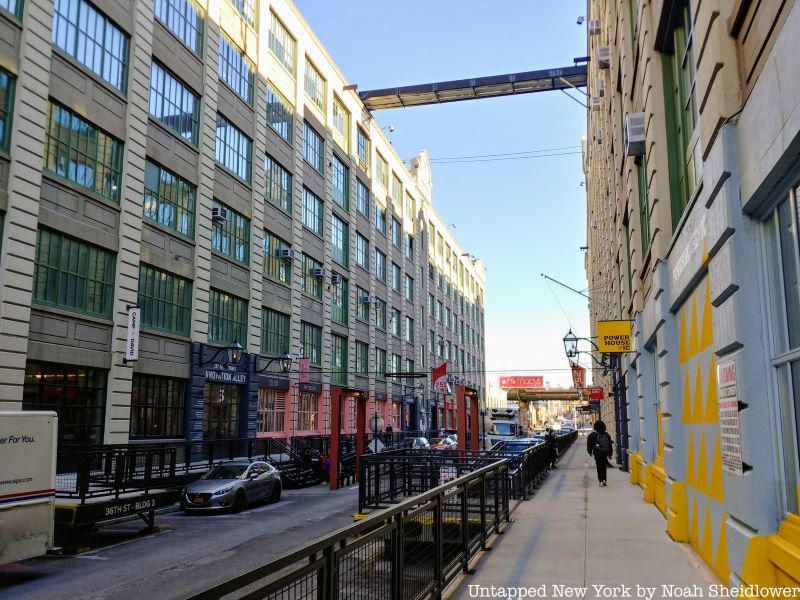
On August 12, 2015, at 5:00 p.m., the Brooklyn-based company AEROBO Aerial Robotics conducted the first legal commercial drone flight in New York City at 220 36th Street, Industry City. As the first company to receive approval from the Federal Aviation Administration to fly a drone, AEROBO’s flight helped to mark the beginning of a new industry that to this day continues to grow. In a New York Business Journal article Aerobo’s co-founders, NYU alumni Brian Streem and Jeff Brink were called “Brooklyn’s Wright Brothers,” with their company working to construct industrial-grade multi-rotor drones capable of flying heavy, professional-grade camera equipment. The specific drone flown at Industry City was an AEROBO X8 equipped with a RED Epic camera that provided footage for a production company making a film about Brooklyn tech companies.
At the time, Aerobo’s drones had already received FAA approval for flights in other parts of the country but New York City remained particularly difficult. As drones weren’t allowed to fly higher than 200 feet, had to also maintain a 500-foot distance from all buildings, unless the building owners had given permission, and were required to remain at least five miles away from all airports many locations in the city failed to meet the necessary criteria. Even so, Industry City ended up meeting the necessary criteria, becoming the perfect location to launch the city’s first legal drone flight.
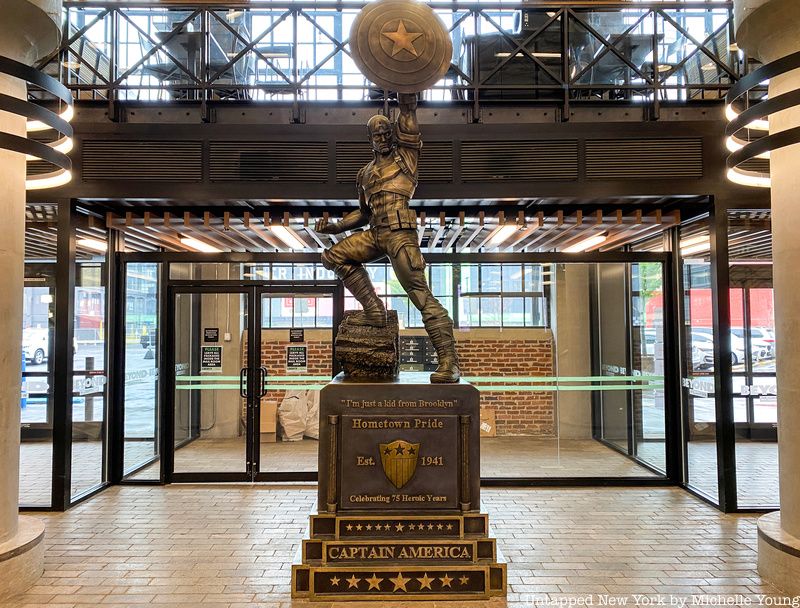
Inside the Liberty View Industrial Plaza—located adjacent to Industry City in a building which once made up part of the larger Bush Terminal—is a 13-foot-tall bronze Captain America statue, stretching all the way up to the mezzanine level of the building’s atrium. The statue features Captain America holding his iconic star shield up to the ceiling in his left hand while his right hand is clenched in a fist. Etched into the bronze plinth on which the statue stands atop are the words “I’m just a kid from Brooklyn,” a phrase taken from the 2011 film Captain America: The First Avenger. Brooklyn-based sculptor David Cortes of Cortes Studios was commissioned by Marvel to make the statue’s design for the 75th anniversary of Captain America—originally created in 1941 by Joe Simon and Jack Kirby. As a native Brooklynite he is known for having made figures not only for Marvel but also for DC and other toy companies. The statue was cast by the company Comicave and unveiled at the 2016 San Diego Comic-Con.
The original plan was to tour the statue around the country, but the idea was met with unexpected resistance. “All of a sudden, there’s all this red tape,” says Cortes. From Comic Con, the statue moved to Brooklyn and was on display in the Children’s Corner at Prospect Park for two weeks. Though many Marvel fans came out en masse to watch the statue’s unveiling, many park goers complained to the local media about how the statue was leading to the commercialization of the public space. Soon after, it was moved to a plaza in front of Barclays Center where it stood for about a month and a half. In the fall of 2016, the statue was gifted by Disney, Marvel’s parent company, to Liberty View Industrial Plaza where it remains today to greet shoppers and passersby alike.
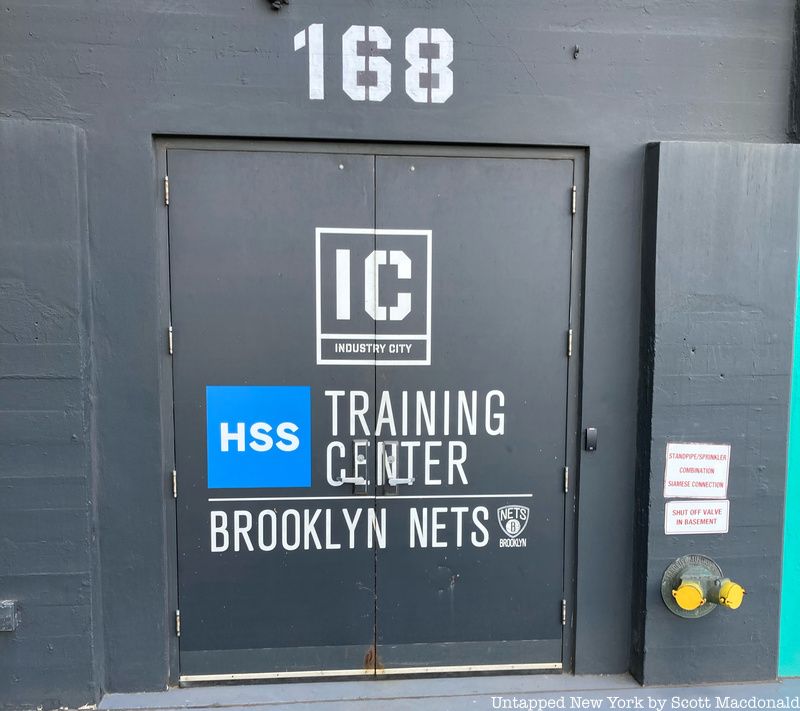
In 2014, the NBA’s Brooklyn Nets made the decision to move their training center to the Industry City complex. The Hospital for Special Surgery (HSS) Training Center opened in 2016 and was built on the eighth floor and rooftop of an empty warehouse in Industry City on 39th Street, occupying 70,000 square feet in total. The facility has two-full basketball courts, a weight room, a training pool, two hydro pools, a rooftop entertainment space, an 18-seat multimedia theater, 3,000 square feet of hospitality/players’ lounge space, and a media interview/workroom. Its exterior design consists of dark metal and glass set against interior finishes that combine an industrial vibe with softer materials creating an overall look that pays homage to Brooklyn’s gritty manufacturing history.
HSS, the official hospital of the Brooklyn Nets, is the leading orthopedic hospital in the country with a highly respected sports medicine program that is the largest and most active in the nation. With a specialization in treating high-performing athletes, HSS is known for its innovation in athletic injury prevention, diagnosis, treatment, and rehabilitation, boasting a research institute complete with 20 laboratories and 300 staff members dedicated to the advancement of musculoskeletal health. In addition, the Hospital for Special Surgery Training Center also hosts youth basketball clinics, community events, and local business development functions.
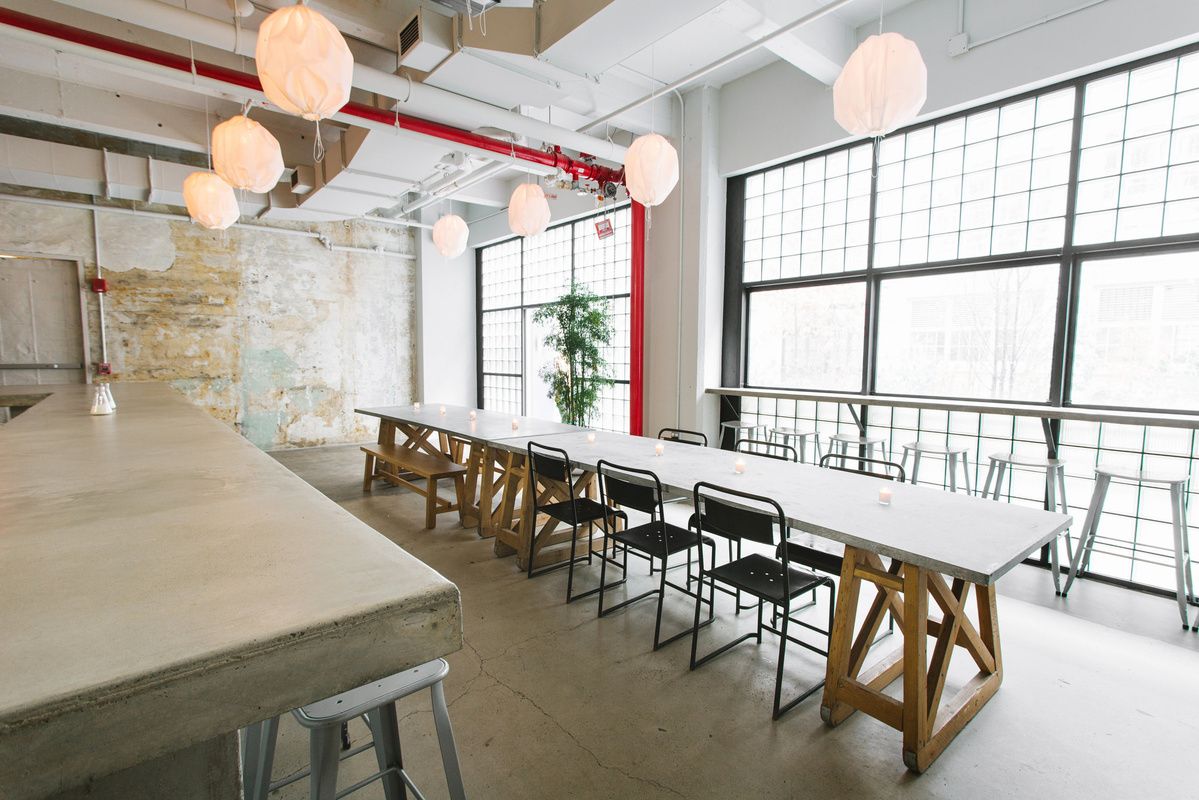
In 2018, Industry City became host to Brooklyn Kura, New York City’s first sake brewery and taproom. Founders Brian Polen and Brandon Doughan joined forces to open Brooklyn Kura after traveling to Japan and apprenticing at breweries where they developed their own unique recipes. Building on more than 1,000 years of Japanese brewing history, Brooklyn Kura works to make sake more accessible while also giving it a uniquely American twist that still respects its origins.
Brooklyn Kura’s craft sake, Junmai, is made entirely from American ingredients such as American-grown rice from California and Arkansas, New York City tap water, koji, and yeast. At Brooklyn Kura’s tap room, special sakes available only on-site can be purchased. A few years after opening in 2021, the brewery entered into a partnership with the Niigata-based Hakkaisan Brewery, one of the most respected in Japan. Brooklyn Kura also has a membership program where monthly subscribers can receive one bottle of the company’s limited release sakes and one bottle of its classic namazake for $65. Besides the alcoholic beverages served, Brooklyn Kura customers can also enjoy bar snacks like toasted nori, cheese plates, and charcuterie boards.
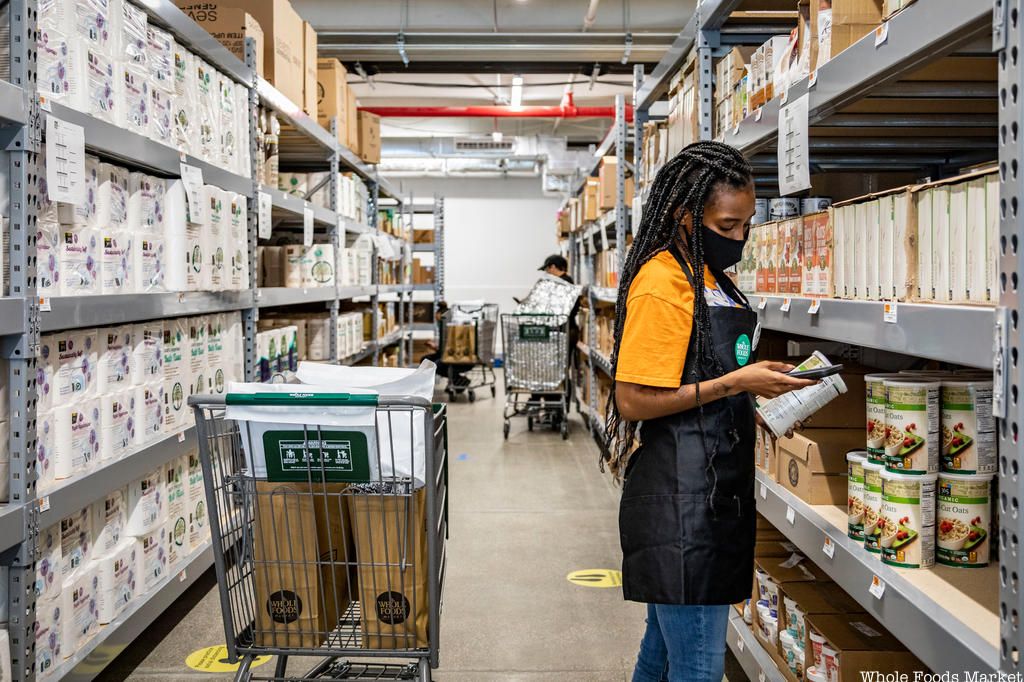
Located inside Industry City is Whole Food Markets’ first permanent online-only store in Brooklyn at 167 41st Street. While the store is closed to the general public it is instead used exclusively to fill the company’s delivery orders for residents of the borough. After the grocery chain was purchased by Amazon in 2017, PrimeNow delivery was introduced, a program that the online-only store works directly to provide for. This new Whole Foods location opened on September 1, 2020, amidst the global coronavirus pandemic, helping to feed into the growing demand for delivery services. In the early months of the pandemic, it had been nearly impossible to secure a delivery slot as city residents sought to stock up on goods without leaving the comfort and safety of their homes.
Nicknamed a “dark store,” Whole Foods’ online-only location is fully managed by hundreds of market team members who are the only individuals allowed inside the store. There they are tasked with bagging all orders. Utilizing a smartphone to ensure that all items for each order have been successfully procured, each bag then receives a bar code which is scanned by staff before the bag is then left on a shelf ready to be delivered.
Next, check out the Top 11 Secrets of Sunset Park In Brooklyn!
Subscribe to our newsletter